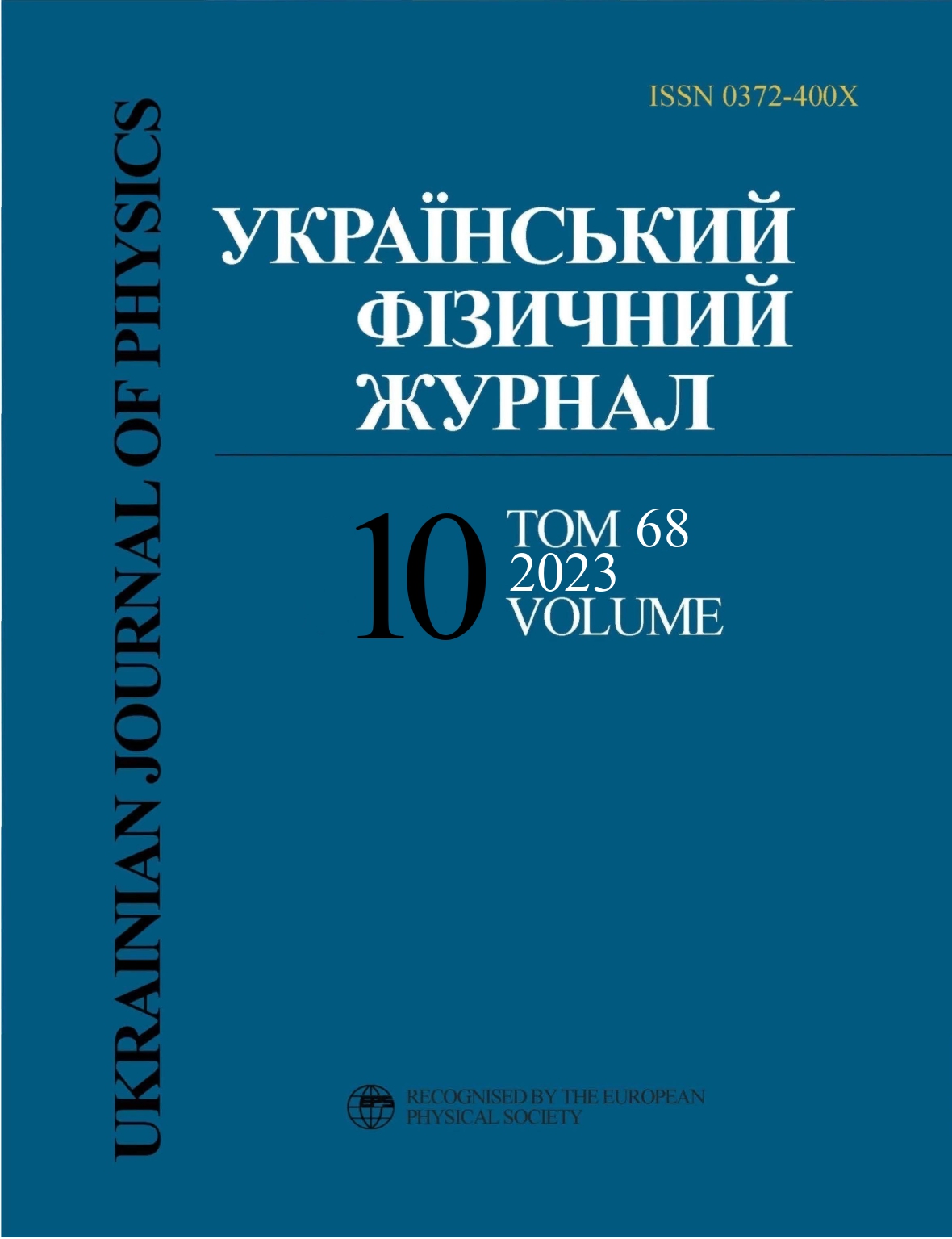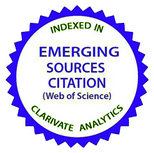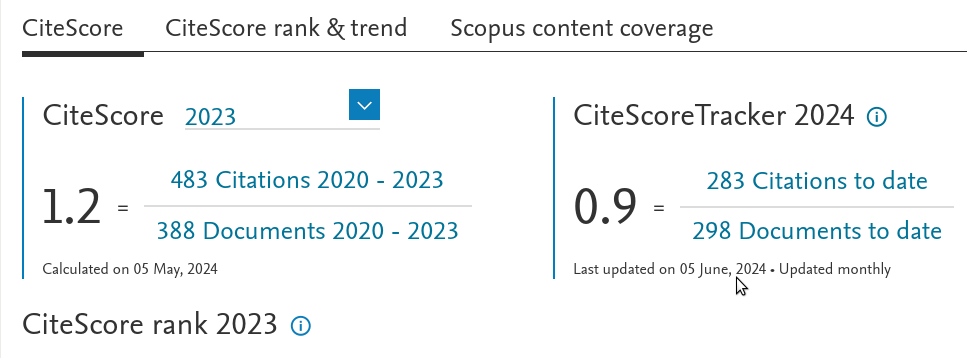Апроксимація електростатичного потенціалу молекули точковими зарядами, що імітують її електронні пари
DOI:
https://doi.org/10.15407/ujpe68.10.673Ключові слова:
електростатична складова енергiї взаємодiї, густина електронного заряду, електростатичний потенцiал молекули, заряди атомiвАнотація
У традицiйних потенцiалах мiжатомної взаємодiї (“силових полях”) їхня електростатична складова iстотно впливає на коректнiсть моделювання ними водневих зв’язкiв та iнших нековалентних взаємодiй, притаманних бiомолекулярним системам. У роботi запропоновано фiзичну модель для апроксимацiї електростатичного потенцiалу молекули (МЕП), засновану на розкладаннi її густини заряду, отриманої з перших принципiв, на локалiзованi складовi. На вiдмiну вiд традицiйних схем, в яких для апроксимацiї МЕП зазвичай використовують точковi заряди, розмiщенi на атомах, у запропонованому пiдходi такi заряди розмiщуються у точках, вибраних так, щоб зiмiтувати анiзотропiю розподiлу електронної густини, зумовлену електронними парами атомiв або ковалентних зв’язкiв. Ця особливiсть приводить до бiльш точного представлення загального електростатичного потенцiалу молекули, що пiдтверджується застосуванням запропонованої моделi для апроксимацiї електростатичної складової мiжмолекулярної взаємодiї в 145 нековалентно-зв’язаних молекулярних комплексах iз бази GMTKN55. У результатi такого застосування було знайдено, що середньоквадратичне вiдхилення апроксимованих значень електростатичної складової енергiї мiжмолекулярної взаємодiї вiд справжнiх для запропонованої моделi становило 2,7 ккал/моль, що у 2,2 рази менше порiвняно з традицiйним методом, заснованим на використаннi RESP-зарядiв на атомах.
Посилання
J.A. Lemkul. Chapter one - pairwise-additive and polarizable atomistic force fields for molecular dynamics simulations of proteins. In: Progress in Molecular Biology and Translational Science, Computational Approaches for Understanding Dynamical Systems: Protein Folding and Assembly. Edited by B. Strodel, B. Barz (Academic Press, 2020).
https://doi.org/10.1016/bs.pmbts.2019.12.009
L. Monticelli, D.P. Tieleman. Force fields for classical molecular dynamics. In: Biomolecular Simulations: Methods and Protocols, Methods in Molecular Biology. Edited by L. Monticelli, E. Salonen (Humana Press, 2013).
https://doi.org/10.1007/978-1-62703-017-5
T.Y. Nikolaienko. Interaction of anticancer drug doxorubicin with sodium oleate bilayer: Insights from molecular dynamics simulations. J. Mol. Liq. 235, 31 (2017).
https://doi.org/10.1016/j.molliq.2016.11.065
G.A. Cisneros, M. Karttunen, P. Ren, C. Sagui. Classical electrostatics for biomolecular simulations. Chem. Rev. 114 (1), 779 (2014).
https://doi.org/10.1021/cr300461d
G.M.A. Junqueira, M.Y. Ballester, M.A.C. Nascimento. Reactivity properties of the hoso and hso2 isomers in liquid medium: a sequential monte carlo/quantum mechanics study. J. Mol. Model. 29 (6), 189 (2023).
https://doi.org/10.1007/s00894-023-05514-7
M. Liu, S. Wang. Mcdock: A monte carlo simulation approach to the molecular docking problem. J. Comput. Aid. Mol. Des. 13 (5), 435 (1999).
K. Coutinho, H.C. Georg, T.L. Fonseca, V. Ludwig, S. Canuto. An efficient statistically converged average configuration for solvent effects. Chem. Phys. Lett. 437 (1), 148 (2007).
https://doi.org/10.1016/j.cplett.2007.02.012
A.A. Adeniyi, M.E. S. Soliman. Implementing qm in docking calculations: Is it a waste of computational time? Drug. Discov. Today 22 (8), 1216 (2017).
https://doi.org/10.1016/j.drudis.2017.06.012
A.I. Samtsevich, L.A. Bulavin, L.F. Sukhodub, T.Y. Nikolaienko. Interaction of dna nucleotide bases with anticancer drug thiotepa: Molecular docking and quantummechanical analysis. Ukr. Biochem. J. 86 (2), 50 (2014).
https://doi.org/10.15407/ubj86.02.050
G.M. Morris, M. Lim-Wilby. Molecular docking. In: Molecular Modeling of Proteins, Methods Molecular Biology. Edited by A. Kukol (Humana Press, 2008).
https://doi.org/10.1007/978-1-59745-177-2_19
M. Huix-Rotllant, N. Ferre. Analytic energy, gradient, and hessian of electrostatic embedding QM/MM based on electrostatic potential-fitted atomic charges scaling linearly with the MM subsystem size. J. Chem. Theory Comput. 17 (1), 538 (2021).
https://doi.org/10.1021/acs.jctc.0c01075
J.F. Gonthier, S.N. Steinmann, M.D. Wodrich, C. Corminboeuf. Quantification of "fuzzy" chemical concepts: A computational perspective. Chem. Soc. Rev. 41 (13), 4671 (2012).
https://doi.org/10.1039/c2cs35037h
S. Riniker. Fixed-charge atomistic force fields for molecular dynamics simulations in the condensed phase: An overview. J. Chem. Inf. Model. 58 (3), 565 (2018).
https://doi.org/10.1021/acs.jcim.8b00042
C. Oostenbrink, A. Villa, A.E. Mark, W.F. Van Gunsteren. A biomolecular force field based on the free enthalpy of hydration and solvation: The GROMOS force-field parameter sets 53A5 and 53A6. J. Comput. Chem. 25 (13), 1656 (2004).
https://doi.org/10.1002/jcc.20090
G. Cavallo, P. Metrangolo, R. Milani, T. Pilati, A. Priimagi, G. Resnati, G. Terraneo. The halogen bond. Chem. Rev. 116 (4), 2478 (2016).
https://doi.org/10.1021/acs.chemrev.5b00484
M.R. Scholfield, C.M.V. Zanden, M. Carter, P.S. Ho. Halogen bonding (X-bonding): A biological perspective. Protein Sci. 22 (2), 139 (2013).
https://doi.org/10.1002/pro.2201
P. Politzer, J.S. Murray, M.C. Concha. σ-hole bonding between like atoms; a fallacy of atomic charges. J. Mol. Model. 14 (8), 659 (2008).
https://doi.org/10.1007/s00894-008-0280-5
T.Y. Nikolaienko, L.A. Bulavin. Localized orbitals for optimal decomposition of molecular properties. Int. J. Quantum Chem. 119 (3), e25798 (2019).
https://doi.org/10.1002/qua.25798
T.Y. Nikolaienko. The maximum occupancy condition for the localized property-optimized orbitals. Phys. Chem. Chem. Phys. 21 (9), 5285 (2019).
https://doi.org/10.1039/C8CP07276K
E.R. Davidson. Reduced Density Matrices in Quantum Chemistry (Academic Press, 1976) [ISBN: 9780122058509].
A.J. Thakkar, A.C. Tanner, V.H. Smith. Inter-relationships between various representations of one-matrices and related densities: A road map and an example. In: Density Matrices and Density Functionals. Edited by R. Erdahl, V.H. Smith (Springer Netherlands, 1987).
https://doi.org/10.1007/978-94-009-3855-7_17
I. Mayer. Bond Orders and Energy Components: Extracting Chemical Information from Molecular Wave Functions (CRC Press, Taylor & Francis, 2017) [ISBN: 9781420090116].
L.D. Landau, E.M. Lifshitz. The Classical Theory of Fields (Pergamon Press, 1975) [ISBN: 9780080181769].
E.R. Davidson, A.E. Clark. A viewpoint on population analyses. Int. J. Quantum Chem. 122 (8) (2022).
https://doi.org/10.1002/qua.26860
J.S. Murray, P. Politzer. The electrostatic potential: An overview. WIRES Comput. Mol. Sci. 1 (2), 153 (2011).
https://doi.org/10.1002/wcms.19
A. Alenaizan, L.A. Burns, C.D. Sherrill. Python implementation of the restrained electrostatic potential charge model. Int. J. Quantum Chem. 120 (2), e26035 (2020).
https://doi.org/10.1002/qua.26035
T. Nikolaienko, L. Bulavin, D. Hovorun. Effective atomic charges of canonical 2-deoxyribonucleotides and their conformational dependences. Uk.r J. Phys. 57 (10), 1024.
T.Y. Nikolaienko, L.A. Bulavin, D.M. Hovorun. Can we treat ab initio atomic charges and bond orders as conformation-independent electronic structure descriptors? RSC Adv. 6 (78), 74785 (2016).
https://doi.org/10.1039/C6RA17055B
L. Goerigk, A. Hansen, C. Bauer, S. Ehrlich, A. Najibi, S. Grimme. A look at the density functional theory zoo with the advanced GMTKN55 database for general main group thermochemistry, kinetics and noncovalent interactions. Phys. Chem. Chem. Phys. 19 (48), 32184 (2017).
https://doi.org/10.1039/C7CP04913G
R.M. Parrish, L.A. Burns, D.G.A. Smith, A.C. Simmonett, A.E. DePrince, E.G. Hohenstein, U. Bozkaya, A.Y. Sokolov, R. Di Remigio, R.M. Richard, J.F. Gonthier, A.M. James, H.R. McAlexander, A. Kumar, M. Saitow, et al. Psi4 1.1: An open-source electronic structure program emphasizing automation, advanced libraries, and interoperability. J. Chem. Theory Comput. 13 (7), 3185 (2017).
https://doi.org/10.1021/acs.jctc.7b00174
T. Lu, F. Chen. Multiwfn: A multifunctional wavefunction analyzer. J. Comput. Chem. 33 (5), 580 (2012).
Downloads
Опубліковано
Як цитувати
Номер
Розділ
Ліцензія
Ліцензійний Договір
на використання Твору
м. Київ, Україна
Відповідальний автор та співавтори (надалі іменовані як Автор(и)) статті, яку він (вони) подають до Українського фізичного журналу, (надалі іменована як Твір) з одного боку та Інститут теоретичної фізики імені М.М. Боголюбова НАН України в особі директора (надалі – Видавець) з іншого боку уклали даний Договір про таке:
1. Предмет договору.
Автор(и) надає(ють) Видавцю безоплатно невиключні права на використання Твору (наукового, технічного або іншого характеру) на умовах, визначених цим Договором.
2. Способи використання Твору.
2.1. Автор(и) надає(ють) Видавцю право на використання Твору таким чином:
2.1.1. Використовувати Твір шляхом його видання в Українському фізичному журналі (далі – Видання) мовою оригіналу та в перекладі на англійську (погоджений Автором(ами) і Видавцем примірник Твору, прийнятого до друку, є невід’ємною частиною Ліцензійного договору).
2.1.2. Переробляти, адаптувати або іншим чином змінювати Твір за погодженням з Автором(ами).
2.1.3. Перекладати Твір у випадку, коли Твір викладений іншою мовою, ніж мова, якою передбачена публікація у Виданні.
2.2. Якщо Автор(и) виявить(лять) бажання використовувати Твір в інший спосіб, як то публікувати перекладену версію Твору (окрім випадку, зазначеного в п. 2.1.3 цього Договору); розміщувати повністю або частково в мережі Інтернет; публікувати Твір в інших, у тому числі іноземних, виданнях; включати Твір як складову частину інших збірників, антологій, енциклопедій тощо, то Автор(и) мають отримати на це письмовий дозвіл від Видавця.
3. Територія використання.
Автор(и) надає(ють) Видавцю право на використання Твору способами, зазначеними у п.п. 2.1.1–2.1.3 цього Договору, на території України, а також право на розповсюдження Твору як невід’ємної складової частини Видання на території України та інших країн шляхом передплати, продажу та безоплатної передачі третій стороні.
4. Строк, на який надаються права.
4.1. Договір є чинним з дати підписання та діє протягом усього часу функціонування Видання.
5. Застереження.
5.1. Автор(и) заявляє(ють), що:
– він/вона є автором (співавтором) Твору;
– авторські права на даний Твір не передані іншій стороні;
– даний Твір не був раніше опублікований і не буде опублікований у будь-якому іншому виданні до публікації його Видавцем (див. також п. 2.2);
– Автор(и) не порушив(ли) права інтелектуальної власності інших осіб. Якщо у Творі наведені матеріали інших осіб за виключенням випадків цитування в обсязі, виправданому науковим, інформаційним або критичним характером Твору, використання таких матеріалів здійснене Автором(ами) з дотриманням норм міжнародного законодавства і законодавства України.
6. Реквізити і підписи сторін.
Видавець: Інститут теоретичної фізики імені М.М. Боголюбова НАН України.
Адреса: м. Київ, вул. Метрологічна 14-б.
Автор: Електронний підпис від імені та за погодження всіх співавторів.

















